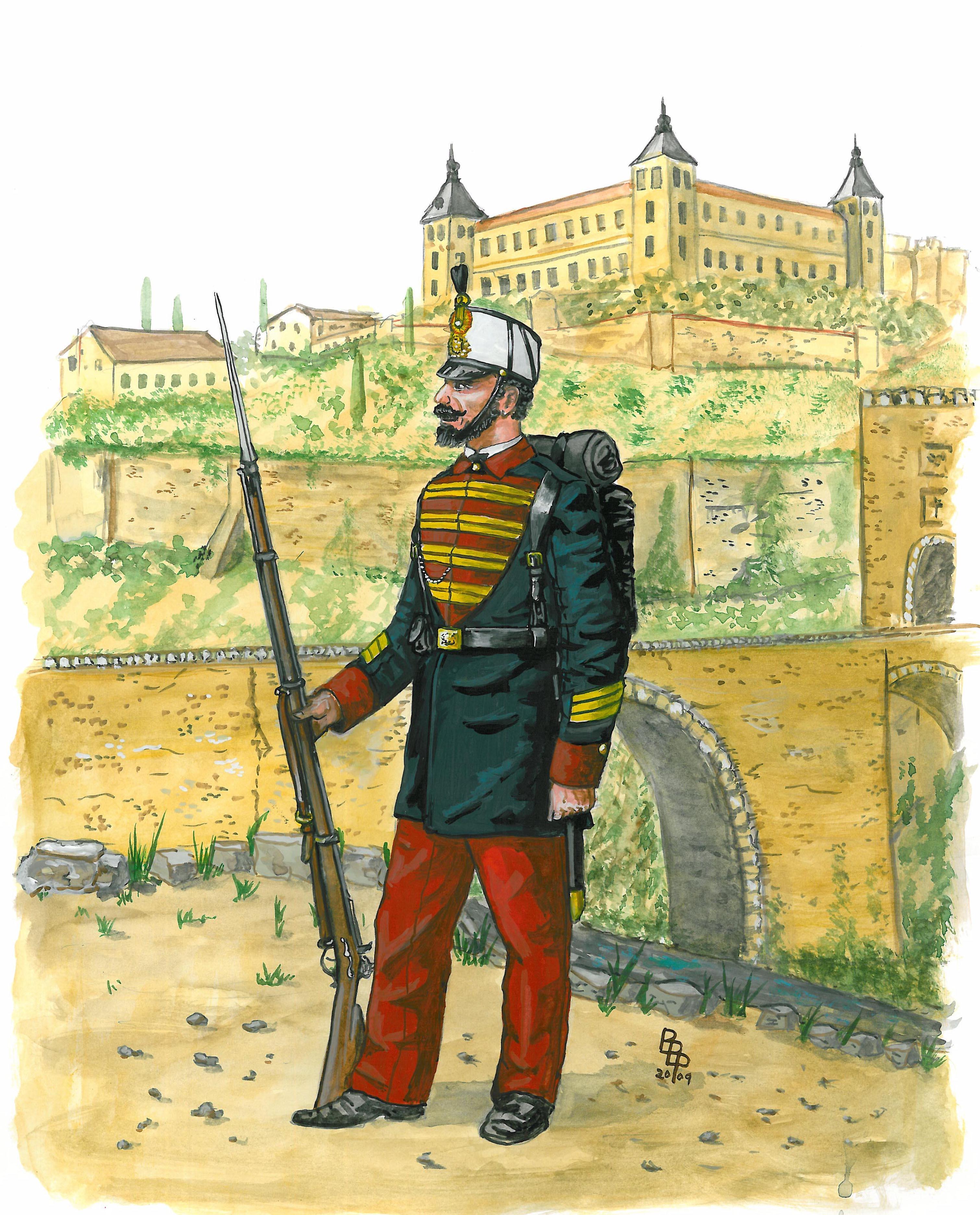Infantry Regiment
Toledo No. 35
Sergeant
1862
Situated in the centre of Spain, on the River Tagus, Toledo is an ancient city with original settlement going back to the Bronze Age. It became an important city in Roman times and later served as the capital of Visigothic Spain. After the Moorish conquest of Spain in the early eighth century, Toledo was an influential centre under the Caliphate of Cordoba and subsequent Islamic regimes until it was taken by Alphonso IV of Castile in the early 13th Century, during the Reconquista. In the 16th Century it was the capital city of Castile, but when the Spanish court moved first to Valadolid and thence to Madrid, its stature declined. It has long been famous for its famous steelmaking, and swords. Located on a great hill, the city is dominated by the Alcazar, a fortress in Roman times and rebuilt in the 1500s. It was the centre of a great siege during the Spanish Civil War (1936-1939) when it was severely damaged. It is now a Military Museum.
Spain has relied on its fighting men of Toledo for many centuries. The city provided troops for the Tercios in the 17th Century the first of which was raised for the war against Portugal in 1661 and known as the 3rd Tercio de Vera (after its commander). In 1664 it was the 3rd Provincial de Toledo and later (1693) the Third Provincial Old Blues. By 1707 it was Infantry Regt. Toledo No. 5. The reforms of 1715 saw the incorporation of the Regiments Sada and Limbourg and a name change to Infantry Regiment Toledo No. 19. There followed many number changes - In 1718 No. 11, in 1741 No. 18 and 1769 No 17. After the Napoleonic Wars, it became a three battalions regiment and is given the title "Infantry Regiment Toledo No 19" . The reorganization of 1823 converts the infantry arm into numbered battalions and Toledo had battalions Nos. 37 & 38. Finally in the year 1847 it was designated Infantry Regiment Toledo No. 35, a number it held for over 100 years. (From 1936-1943 it was No. 26).
The regiment fought in all the Major wars in which Spain took part. During the War of Spanish Succession it was at Almanza, and the defence of Ceuta. It was in almost continuous duty between 1718 and 1740 when during the War of Austrian Succession, it went to Italy taking part in the pivotal Battle of Piacenza, among many others. The Seven Years War saw it in Puerto Rico and Havana and in the American War of Independence it was in Florida. During its own War of Independence (1808-1815) it fought in every theatre particularly at the battles of Medina de Rio Seco, Bilbao and Espinosa de los Monteros, the actions at Villafranca del Bierzo and Lugo, Tamames and Medina del Campo and the defence of Cáceres and Badajoz where the regiment was almost destroyed. Later it fought at the battles of Almansa and San Marcial. After a long peace the Regiment was sent to Morrocco in the war there from 1859 -60. They were also in Cuba during the Spanish American War taking part in the action of Guantanamo. During the Spanish Civil War it raised over 20 battalions and were in nearly every major action. The regiment was finally disbanded in 1987 when, as new members of NATO, Spain reorganized its armed forces.
The regiment always wore the regular white uniform of the Spanish infantry with its characteristic blue facings, which over the years changed from a darkish blue to sky blue in 1790. In 1811, during the War of Independence shortages of clothing led to a British provided uniform of brown coatee with yellow collar, lapels and cuffs. A black bell topped shako with white band around the top was worn. In 1815 all regiments wore blue coatees lined red with black shakos and the Toledo regiment had white facings. In 1821 the tunic lost its lapels and all the infantry adopted crimson collars and the cuffs and piping were scarlet (For the Toledo regiment, the shoulder straps were white). After a brief flirtation with a green coatee with yellow piping in the early 1840s, a more conventional blue coatee was worn with red facings for all regiments. A completely new uniform was adopted in the early 1850s which consisted of a blue tunic with long skirts and madder red trousers. The facings were red and the lapels were worn open with yellow loops showing. The most interesting item was the uniquely shaped white shako called a Ros. This is the uniform which with minor modifications according to fashion was worn until the First World War and which is worn today by the Guardia Real (Royal Guard) on parade.
The illustration shows a sargento in about 1862 with the Alcazar in the background.





